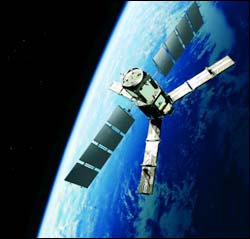In a study published in Geophysical Research Letters (Vol. 31, No.18), University of South Florida College of Marine Science professor Boris Galperin and colleagues explain a link between the movement and appearance of ocean currents on Earth and the bands that characterize the surface of Jupiter and some other giant planets.
“The banded structure of Jupiter has long been a subject of fascination and intensive research,” says Galperin, a physical oceanographer who analyzes turbulence theo
Scientists have discovered a striking similarity between certain ocean currents on Earth and the bands that characterize the surface of large, gaseous planets like Jupiter. Boris Galperin of the University of South Florida’s College of Marine Science in Saint Petersburg and colleagues in the United States, Israel, and Japan report their findings later this month in Geophysical Research Letters, published by the American Geophysical Union. “The banded structure of Jupiter has long been a
Whenever a hurricane races across the Atlantic Ocean, chances are phytoplankton will bloom behind it. According to a new study using NASA satellite data, these phytoplankton blooms may also affect the Earth’s climate and carbon cycle.
Dr. Steven Babin, a researcher at the Johns Hopkins University Applied Physics Laboratory in Laurel, Md., studied 13 North Atlantic hurricanes between 1998 and 2001. Ocean color data from the SeaWiFS instrument on the SeaStar satellite were used to analyze l

A significant milestone in the development of ESA’s Soil Moisture and Ocean Salinity (SMOS) mission was reached last week when the contract to build the payload was signed between ESA and EADS (European Aeronautic Defence and Space Company)-CASA from Spain.
The contract, worth 62 million euros, was signed in Madrid, Spain on 11 June 2004 at the premises of the CDTI (Centre for Development of Industrial Technology). EADS-CASA now heads an industrial consortium of more than 20 companie
Long before a Hollywood blockbuster about catastrophic climate change packed cinema multiplexes this spring, researchers at the top of the world, supported by the National Science Foundation (NSF), were using an array of scientific tools to build a comprehensive scientific picture of environmental change in the Arctic and what it may mean for the rest of the globe. Led by oceanographer James Morison, of the University of Washington, NSF-supported scientists from Oregon State University, as we
Old fish bones can tell scientists about more than what people used to eat. They can also provide clues to the climate in which those people lived. In the scientific journal Quaternary Research, a team led by three University of Maine scientists reports using fish bones from an archaeological site in Peru to describe the timing of Pacific Ocean climate cycles linked to El Nino.
The report provides new evidence for a theory stating that biological cycles in the world’s oceans reflect su